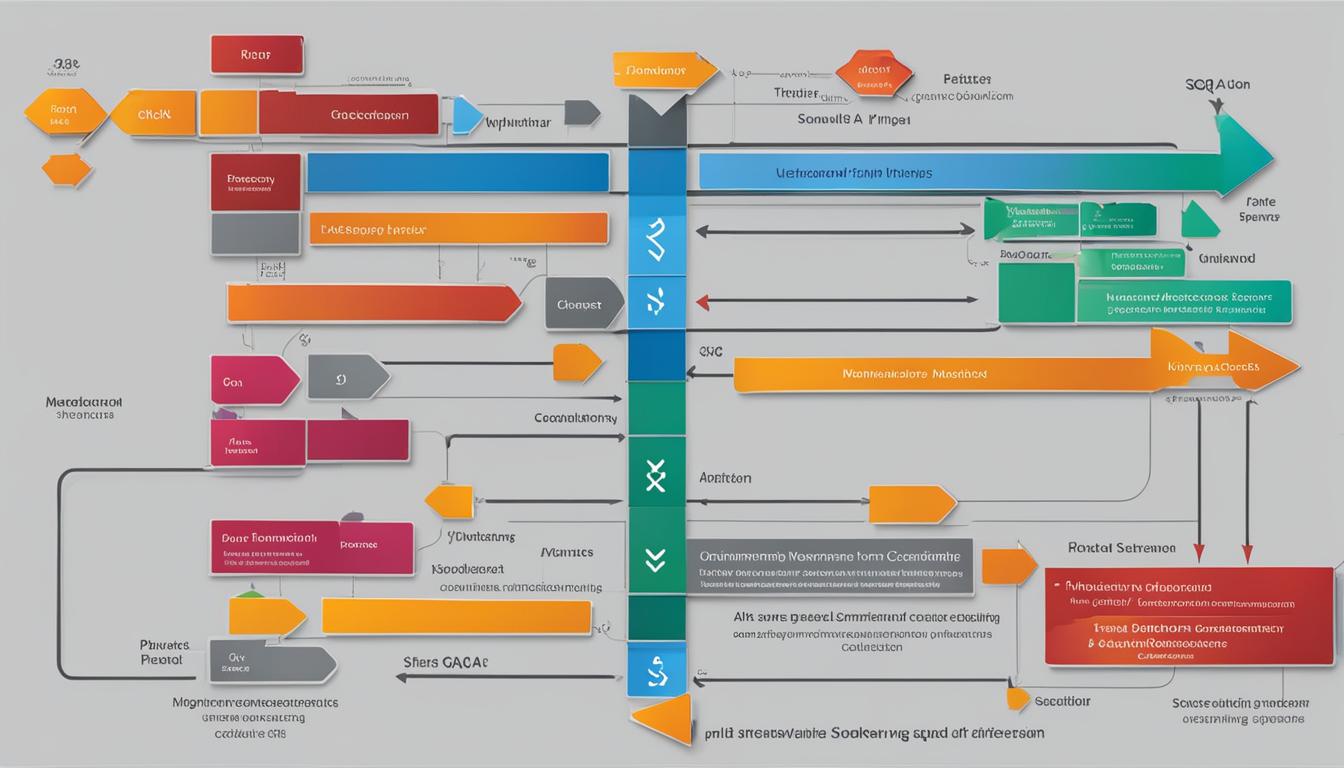We understand that keeping up with the newest trends in software quality assurance (SQA) can be challenging, particularly with the rapid advancement of technology.
However, as professionals in the field, we must stay informed about the latest developments to ensure our practices remain effective and efficient.
In 2024, the landscape of SQA is poised to undergo significant changes, from the integration of AI in testing to the impact of mobile testing on overall strategies.
These emerging trends are not only intriguing but also have the potential to reshape the way we approach quality assurance.
Stay tuned to discover how these developments could shape the future of SQA and the implications for our work.
Key Takeaways
- Test automation is revolutionizing software development, replacing manual testing with efficient automated solutions.
- The integration of AI in testing is enhancing efficiency, accuracy, and maintenance of test cases, as well as revolutionizing test management and support.
- DevOps practices emphasize seamless coordination of development and operations, with test automation as a cornerstone, and the integration of AI and machine learning to enhance testing practices.
- The shift towards autonomous testing, with minimal human intervention and AI integration, is streamlining test creation and maintenance, optimizing QA processes, and aligning with Agile and DevOps principles.
Advancements in Test Automation
Advancements in test automation have revolutionized the software development process, streamlining regression testing and replacing manual testing with efficient, automated solutions. As organizations strive for DevOps excellence, the adoption of automation in software testing is a pivotal component in achieving seamless integration and delivery.
Despite the current automation rate being less than 20%, the evolving landscape of testing tools and technologies presents an opportunity to elevate this figure. Automation tools such as Selenium, Katalon, and TestComplete are continuously enhancing their capabilities, catering to the increasing demands of the industry. Mobile automation, in particular, is experiencing a surge as mobile app testing becomes a critical facet of DevOps toolchains.
Furthermore, the emergence of API and service test automation underscores the necessity for adept solutions in automating API tests. In the era of technology and digital transformation, the integration of artificial intelligence in testing tools is laying the groundwork for a more intelligent and efficient testing process.
As we delve into the future of SQA, these advancements in test automation will be integral in shaping the software testing trends for 2024 and beyond.
Integration of AI in Testing

How can AI integration in testing enhance the efficiency and accuracy of test case generation and defect prevention? The integration of AI in testing presents a paradigm shift in software quality assurance (SQA). By leveraging predictive models and machine learning, AI enhances the precision and effectiveness of test case generation. It enables the proactive identification of potential defects through predictive analytics, thereby preventing issues before they arise. Furthermore, AI-driven automation streamlines test script maintenance, saving time and resources. Additionally, AI-powered chatbots are revolutionizing test management and support, providing real-time assistance and insights. Test data generation and analysis are also being optimized through AI integration, ensuring comprehensive test coverage.
To illustrate the diverse applications of AI integration in testing, consider the following table:
| AI Integration Applications in Testing | Benefits |
|---|---|
| Test Case Generation | Enhanced precision and efficiency |
| Defect Prevention | Proactive identification of potential issues |
| Automated Test Script Maintenance | Time and resource savings |
| AI-driven Chatbots | Real-time assistance and insights |
The integration of AI in testing represents a progressive trend that elevates the standards of SQA, promising unparalleled efficiency and accuracy.
Evolution of DevOps Practices
The integration of AI in testing has paved the way for the evolution of DevOps practices, emphasizing the seamless coordination of development and operations activities to optimize the software lifecycle. In the current landscape of technological advancements, DevOps has become integral to software development, aligning with Agile methodologies to ensure rapid and high-quality deliverables. Test automation is a cornerstone of DevOps practices, focusing on continuous integration and regression testing to maintain software quality while accelerating the development process. Notably, API and services test automation are gaining prominence, playing a pivotal role in efficient application design and delivery.
As we delve into the evolution of DevOps practices, it’s imperative to recognize the significance of testing techniques in this paradigm. The utilization of AI and Machine Learning presents unique opportunities to enhance testing practices, enabling predictive analytics for identifying potential issues and optimizing testing efforts. This evolution underscores the proactive approach to software quality, where DevOps practices continually adapt to meet the demands of modern software development.
Shift Towards Autonomous Testing

Autonomous testing is revolutionizing the QA landscape with its goal of minimizing human intervention and streamlining test creation and maintenance for business users. As organizations embrace this emerging trend, several significant developments are shaping the shift towards autonomous testing:
- AI Integration: Autonomous testing leverages AI for intelligent test scoping, self-healing, and predictive testing, marking a paradigm shift in the software lifecycle from development to testing.
- Investment in AI: Organizations are consistently investing in AI to optimize QA processes, emphasizing AI augmentation in QA, and paving the way for democratizing automation.
- Vendor Standards: Microsoft’s emphasis on quality and continuous updates is setting new standards, indicating a potential industry-wide adoption of advanced methods and tools.
The shift towards autonomous testing aligns with the principles of Agile and DevOps, offering enhanced testing for mobile apps through mobile test automation and leveraging cloud-based mobile device labs. This evolution is indicative of a proactive approach to testing, emphasizing precision and efficiency in the ever-changing landscape of software testing trends.
Impact of Mobile Testing
In mobile testing, our focus is on ensuring the compatibility, performance, and security of applications across diverse platforms, reflecting the critical role of mobile testing in meeting the ever-growing demand for high-quality mobile experiences. The impact of mobile testing is profound as the landscape of mobile devices and platforms continues to evolve. With the rapid development and deployment of mobile applications, robust testing practices are essential to deliver superior quality and seamless user experiences. Mobile testing not only influences the quality prediction of applications but also plays a pivotal role in the overall delivery of mobile solutions.
The impact of mobile testing extends to the development process, where the integration of advanced testing tools and automation testing frameworks is becoming increasingly crucial. As the reliance on mobile devices for various tasks escalates, the demand for effective mobile testing tools and methodologies has surged. Moreover, the emergence of new trends in mobile testing, such as the integration between cloud-based mobile device labs and test automation tools, has significantly influenced the efficiency and effectiveness of mobile testing practices.
As the mobile landscape continues to evolve, the impact of mobile testing on the quality and delivery of mobile applications remains paramount.
Frequently Asked Questions
What Is the Future of Qa?
We see the future of QA evolving towards increased automation, integration of AI and machine learning, and a shift towards Agile and DevOps methodologies.
This will lead to improved testing efficiency, collaboration between development and testing teams, and a growing emphasis on mobile and IoT testing.
Additionally, AI will play a significant role in test case generation, predictive analytics, and blockchain testing.
These trends are shaping a future of QA that’s dynamic, efficient, and technologically advanced.
What Is New in Quality Assurance?
In quality assurance, we’re witnessing advancements like increased automation with AI and machine learning, enhancing accuracy and reliability.
Agile and DevOps testing is emphasizing continuous testing, early defect detection, and collaboration.
Mobile testing is evolving with diverse device compatibility and cloud-based environments.
AI is being integrated for test case generation and predictive analytics.
Blockchain testing is focusing on security, privacy, and integration testing.
These trends reflect a proactive shift towards more efficient and comprehensive testing methodologies.
What Is New in Software Testing in the Digital Era?
In software testing, the digital era brings a focus on automation, AI, and machine learning for improved accuracy and efficiency. Agile and DevOps methodologies drive continuous testing and integration, early defect detection, and collaboration using tools like Jenkins, Docker, and Kubernetes.
Mobile app testing requires diverse device and OS testing, performance, and security testing.
IoT and cloud-based testing emphasize complex IoT ecosystem testing and scalable, secure cloud environments.
What Is the Future Scope of Software Testing?
The future scope of software testing encompasses:
- Advanced automation with AI and machine learning
- Agile and DevOps methodologies for continuous testing
- Increased focus on mobile and IoT testing
Our team is constantly adapting to these changes, integrating new tools and technologies for improved accuracy, reliability, and scalability. We prioritize:
- Early defect detection
- Faster time-to-market
While addressing:
- Diverse device and OS fragmentation
- Security testing
- Performance testing
Our proactive approach ensures we stay ahead in this dynamic landscape.
Conclusion
In conclusion, the emerging trends in SQA for 2024 are revolutionizing the way we approach testing.
With the increasing demand for mobile applications, it’s crucial to note that by 2024, it’s projected that there will be over 7 billion mobile users worldwide. This statistic highlights the importance of staying ahead of the curve in mobile testing to ensure compatibility, performance, and security across diverse devices and platforms.
Stay proactive and embrace these advancements to thrive in the evolving landscape of SQA.
At the helm of our content team is Amelia, our esteemed Editor-in-Chief. Her extensive background in technical writing is matched by her deep-seated passion for technology. Amelia has a remarkable ability to distill complex technical concepts into content that is not only clear and engaging but also easily accessible to a wide range of audiences. Her commitment to maintaining high-quality standards and her keen understanding of what our audience seeks are what make her an invaluable leader at EarnQA. Under Amelia’s stewardship, our content does more than just educate; it inspires and sets new benchmarks in the realm of QA education.










